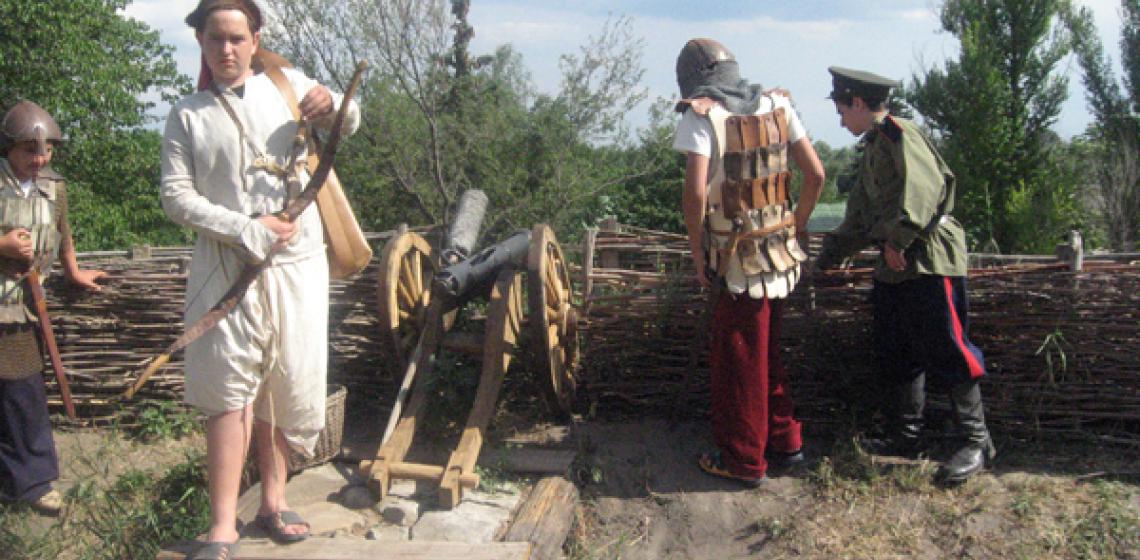The Lost World (RU)

Ethno-archaeological complex "The Lost World" combines research with cultural tourism and recreation. The project is carried out on the initiative and with the participation of the Don Archaeological Society and NP "Yuzharheologiya" . One can visit the Stone Age, Bronze Age, Iron Age and a Cossack type Village.
The Stone Age Village consists of huts, a sanctuary and workshops. The village refers to the Mesolithic and Neolithic before they had ceramics. The huts are a simple wooden frame covered with two layers of reeds. The door is a piece of leather on a wooden frame. The dimensions are about 5x3 m. and building it took about two weeks and has not been changed in three years - it is well protected from heavy rain in summer and autumn and in winter they stand in 30-50 cm snow.
To increase the internal space in Hut Two, after the carcass structure, it was decided to deepen the floor. The result are earthen bunks along the walls, which are flush with the surface. The roof is covered with reeds in three layers. The hut measures
6x4,5 m and has a depth of 60 cm with an entrance-corridor. The walls are made of braided reeds, plastered with clay. It took 3.5 weeks to build it.
The centre of the ancient settlement is the sacred place, where important events of the tribe take place. The sanctuary consists of a circle of vertically set slabs of sandstone. This stone circle is directly adjacent to the wooden sculptures which carries a mask of zoomorphic and anthropomorphic features based on bone amulets Neolithic Razdorskaya 2. Near the statues is a flat slab of stone - the altar.
The flint workshop is a wooden structure without walls, covered with reed and measures 2x4 m. The canopy protects the flintknapper from sun and rain. Stone processing is a difficult process and requires certain skills. However, under the guidance of an experienced specialist everybody can learn.
Interest in the skins goes back a long time. Ancient people used all parts of slain animals. The skins were used for different areas of the economy: the construction of housing, sewing clothes and shoes, etc. The processing of hides is quite labour intensive, and is divided into several stages. From archaeological evidence we know that people started to make clothes in the Palaeolithic. People knew how to sew animal skins, using bone needles.
The settlement of the Bronze Age consists of two residential buildings (one unfinished), a sanctuary, a shelter and a material and equipment storage.
The first Bronze Age house was built in 2011. It is equipped with beds, a work area for weaving and the manufacture of pottery. The building measures 11x6 M. The diameter of the central row of pillars was 60-80 cm. The height of the structure is 3.5 m.
An Iron Age – medieval building was constructed, recessed into the ground with stone walls and plank roof. In its construction, we relied on information about the earliest stages of the stone house-building in the region. Already from the Bronze Age stone huts with dry walls are known. The construction took a fair amount of time and it was very time-consuming – it included a few dozen cubic meters of stone.
This house is designed to demonstrate the elements of the military and culinary culture in the time interval from the Iron Age to the Middle Ages. Of all the buildings of the complex this house is the most functional - here you can relax, have a snack and join in a festive event. It is planned to reconstruct the ancient and medieval cooking methods based on ancient recipes.
The Steppenwolf mound is a copy of an earthen burial structure. This is the second reconstructed mound in Russia, the first can be found in Arkaim. This guided tour includes visits to the interior of the mound, where burials, typical of different historical eras are shown. The mound covers a long cross-shaped space of 15 x 10 m. The interior comprises of two opposing rooms, one for adult burials and two smaller for children. On top of the chambers a 5-meter-high mound is built.
The Cossack village is both an old and new project of "Lost World." It is old because the ethnographic Cossack component is always present. It is new because we are trying to show the culture of the Cossacks in a new, more lively, realistic and interesting level. In the Cossack village one visits a complex of buildings (castle, hut, a mill, workshops, smithy), typical of the culture of the Don Cossacks. It is a live interactive direct immersion in the life of the indigenous population of these places. The interactive program consists of two large units: life and military affairs of the Cossacks including visiting a tree-earthen field fortification called a redoubt. Such prefabricated fortifications were widely used in the Middle Ages. Even a small garrison successfully repelled the attack of the enemy lightly, especially light cavalry nomads. The redoubt has a horseshoe shape. Additional security features are pointed stakes and a double fence along the crest. It is planned to install a three-gun battery.
Source Text & Photo: website the Lost World
